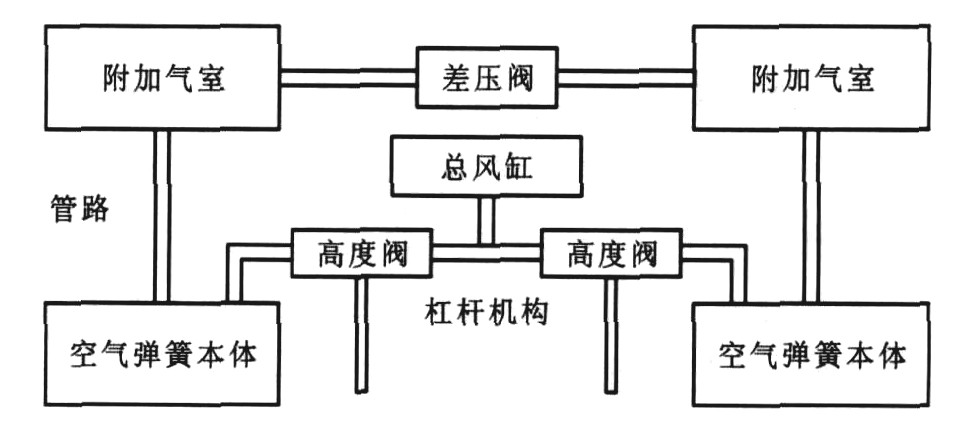Influence of air spring on curve negotiating property of vehicle
Article Text (Baidu Translation)
-
摘要: 建立了考虑左右空气弹簧垂向耦合模型的车辆系统数学模型, 由理想气体的状态方程得到空气弹簧的力学方程, 分析了车辆通过曲线时车辆与空气弹簧的动态特性。仿真结果表明: 由于高度阀的动作, 车辆在驶出曲线后各空气弹簧的压力不一致, 导致车体不能回到静平衡位置; 车辆以正常速度通过曲线时, 车辆曲线通过动力学性能变化不大; 在车辆多次通过同一种曲线的较恶劣工况时, 空气弹簧内气压变化范围是一定的; 增加抗侧滚刚度能明显抑制车体侧滚, 从而减小空气弹簧内气压的变化量; 增大空气弹簧横向跨距, 并选择合适的刚度和阻尼, 能使车辆驶出曲线后各空气弹簧压力接近静平衡值。Abstract: The coupled vertical model of left and right air springs was considered, a mathematical model of vehicle system was set up, the dynamic equations of air spring were derived from the state equations of ideal gas, and the dynamic performances of vehicle and air spring were simulated when vehicle passed through curve.Simulation result shows that because of the action of leveling valves, the pressures of air springs are different, so that the displacement of car body does not tend to zero after curve negotiation; when vehicle runs along curve at normal speed, its dynamic curving performance varies little; when vehicle passes through the same curve time after time, the pressure's mutative range of air spring is certain; the increase of anti-roll stiffness reduces the roll angle of car body and the pressure change of air spring; the lateral distance increase between air springs and choosing appropriate stiffness and damping of air spring may keep the pressure of air spring tending to its static equilibrium value after vehicle passes through the curve.
-
Key words:
- vehicle engineering /
- vehicle system dynamics /
- air spring /
- anti-roll bar /
- numerical simulation
-
-
[1] 陆海英. 现代轨道交通车辆的空气弹簧悬挂技术[J]. 机车电传动, 2003, 44(4): 36-42. doi: 10.3969/j.issn.1000-128X.2003.04.011Lu Hai-ying. Air spring suspension technology of modern railtransit vehicles[J]. Electric Drive for Locomotives, 2003, 44(4): 36-42. (in Chinese) doi: 10.3969/j.issn.1000-128X.2003.04.011 [2] 邬平波, 薛世海, 杨晨辉. 基于弹性车体模型的高速客车动态响应[J]. 交通运输工程学报, 2005, 5(2): 5-8. doi: 10.3321/j.issn:1671-1637.2005.02.002Wu Ping-bo, Xue Shi-hai, Yang Chen-hui. Dynamic response of high-speed passenger car based on flexible car body model[J]. Journal of Traffic and Transportation Engineering, 2005, 5(2): 5-8. (in Chinese) doi: 10.3321/j.issn:1671-1637.2005.02.002 [3] 王开云, 翟婉明, 刘建新, 等. 线路不平顺波长对提速列车横向舒适性影响[J]. 交通运输工程学报, 2007, 7(1): 1-5. doi: 10.3321/j.issn:1671-1637.2007.01.001Wang Kai-yun, Zhai Wan-ming, Liu Jian-xin, et al. Effect of rail irregularity wavelength on lateral running comfort of speed-raised train[J]. Journal of Traffic and Transportation Engineering, 2007, 7(1): 1-5. (in Chinese) doi: 10.3321/j.issn:1671-1637.2007.01.001 [4] 张广世, 沈钢. 带有连接管路的空气弹簧动力学模型[J]. 铁道学报, 2005, 27(4): 36-41. doi: 10.3321/j.issn:1001-8360.2005.04.008Zhang Guang-shi, Shen Gang. Study on dynamic air spring model with connecting pipe[J]. Journal of China Railway Society, 2005, 27(4): 36-41. (in Chinese) doi: 10.3321/j.issn:1001-8360.2005.04.008 [5] 张广世, 郭荣生. 延迟型高度阀特性参数的研究[J]. 铁道车辆, 2006, 44(2): 1-4. https://www.cnki.com.cn/Article/CJFDTOTAL-TDCL200602000.htmZhang Guang-shi, Guo Rong-sheng. Research on the feature parameters of the retard type leveling valve[J]. Rolling Stock, 2006, 44(2): 1-4. (in Chinese) https://www.cnki.com.cn/Article/CJFDTOTAL-TDCL200602000.htm [6] 张洪, 吕任远, 王志春, 等. 空气弹簧转向架减振形式分析[J]. 铁道车辆, 2006, 44(8): 1-6. doi: 10.3969/j.issn.1002-7602.2006.08.001Zhang Hong, Lu Ren-yuan, Wang Zhi-chun, et al. Analysisof damping modes for bogies with air springs[J]. Rolling Stock, 2006, 44(8): 1-6. (in Chinese) doi: 10.3969/j.issn.1002-7602.2006.08.001 [7] 刘增华, 李芾, 傅茂海, 等. 铁道车辆空气弹簧系统最优控制策略及方法研究[J]. 铁道学报, 2006, 28(1): 26-30. https://www.cnki.com.cn/Article/CJFDTOTAL-TDXB200601005.htmLiu Zeng-hua, Li Fu, Fu Mao-hai, et al. Study on the optimal control tactics and method about rail vehicle air springsystems[J]. Journal of China Railway Society, 2006, 28(1): 26-30. (in Chinese) https://www.cnki.com.cn/Article/CJFDTOTAL-TDXB200601005.htm [8] Wang Wen-jun, Suda Y. Control of air suspension to preventwheel load reduction at transition curve negotiation[C]//Shen Zhi-yun. Proceedings of international symposium on speed-up and service technology for railway and maglev system. Chengdu: Southwest Jiaotong University Press, 2006: 269-274. [9] 朱思洪, 吕宝占, 王辉, 等. 汽车半主动空气悬架的神经网络控制方法[J]. 交通运输工程学报, 2006, 6(4): 66-70. https://www.cnki.com.cn/Article/CJFDTOTAL-JYGC200604014.htmZhu Si-hong, Lu Bao-zhan, Wang Hui, et al. Neural network control method of automotive semi-active air suspension[J]. Journal of Traffic and Transportation Engineering, 2006, 6(4): 66-70. (in Chinese) https://www.cnki.com.cn/Article/CJFDTOTAL-JYGC200604014.htm [10] 原亮明, 宫相太, 刘爽堃, 等. 铁道车辆空气弹簧垂向动态特性分析方法的研究[J]. 中国铁道科学, 2004, 25(4): 37-41. https://www.cnki.com.cn/Article/CJFDTOTAL-ZGTK200404006.htmYuan Liang-ming, Gong Xiang-tai, Liu Shuang-kun, et al. Study on vertical dynamic characteristics analysis method for railway vehicle air spring[J]. China Railway Science, 2004, 25(4): 37-41. (in Chinese) https://www.cnki.com.cn/Article/CJFDTOTAL-ZGTK200404006.htm -





 下载:
下载:







